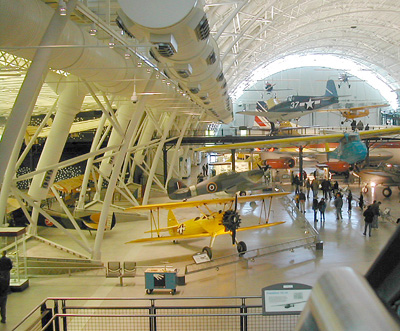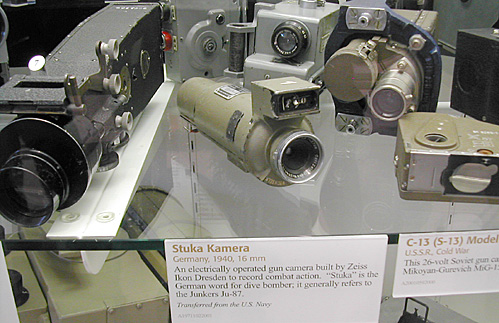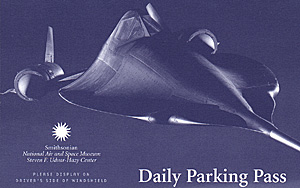 Whenever I mentioned that I went to the Udvar-Hazy Center, I received a lot of blank stares, followed by the question, "The what center?" And when I replied with "Udvar-Hazy," the stares changed to furrowed brows and vague bemused grimaces implying I was trying to pull a fast one. When I explained the center was the newest museum building in the Smithsonian's arsenal of artifacts, the mist of scepticsm lifted from their spirits...and about half of them knew it housed aircraft.
Whenever I mentioned that I went to the Udvar-Hazy Center, I received a lot of blank stares, followed by the question, "The what center?" And when I replied with "Udvar-Hazy," the stares changed to furrowed brows and vague bemused grimaces implying I was trying to pull a fast one. When I explained the center was the newest museum building in the Smithsonian's arsenal of artifacts, the mist of scepticsm lifted from their spirits...and about half of them knew it housed aircraft.
At right, the $65 million dollar man, Steven F. Udvar-Hazy
It takes a bunch of bucks to slap your name on a museum building, and Steven F. Udvar-Hazy plunked down a cool $65 million for the privelege. A Hungarian immigrant who went on to own an aircraft leasing company, International Lease Finance Corp (now part of AIG), the official spin is that he wanted to repay the country for his chance at freedom. He probably also thought it would be quite grand to have a museum named after him.
You and I, via US government funding, kicked in $17 million, and the rest of the money, eventually a total of $311 million, came from a variety of private sources. I imagine that includes Donald D. Engen, who may be slightly better known than Udvar-Hazy (Engen was the director of the National Air and Space Museum) and has an observation tower named after him, and James S. McDonnell, who you may know from McDonnell-Douglas and has a Space Hanger named after him.
They didn't name anything after Russell S. Lockwood, but I'm going to stake a claim to an inch-long strip of tile grout in the second-floor men's bathroom at the entrance to the James S. McDonnell Space Hanger. I figure that 17 million dollars divided by 300 million people equals 5.6 cents, and that's about an inch worth of tile goo. My wife, Susan D. Lockwood, said that if there were cost overruns, I could have her nickel-plus funding as well, so that would be 11.2 cents. That's certainly worth an inch of history.
Seriously, the museum's a bit short towards its $311 million goal--about $92 million as of December 2003. Despite owning $18 billion in aircraft assets, evidently AIG couldn't fork over the $92 million. That leaves the rest of us. There's an outside wall of honor where $100 gets your name here.
 The Smithsonian's Udvar-Hazy Center (UHC), which opened December 17, 2003, displays a variety of aircraft and associated gear from WWI to the space age. The cavernous 984-foot-long interior of its hanger-like structure offers plenty of room (eventually 760,000-square feet) for the 100 or so aircraft on display. In comparison, the Air and Space Museum on the Mall in DC offers 161,000 sq. feet. That probably should be computed into cubic feet, as about half the planes seem to be hung from the 10-story-tall rafters. Ultimately, the UHC will contain about 200 aircraft plus about 150 space-related items.
The Smithsonian's Udvar-Hazy Center (UHC), which opened December 17, 2003, displays a variety of aircraft and associated gear from WWI to the space age. The cavernous 984-foot-long interior of its hanger-like structure offers plenty of room (eventually 760,000-square feet) for the 100 or so aircraft on display. In comparison, the Air and Space Museum on the Mall in DC offers 161,000 sq. feet. That probably should be computed into cubic feet, as about half the planes seem to be hung from the 10-story-tall rafters. Ultimately, the UHC will contain about 200 aircraft plus about 150 space-related items.
From the entryway, looking west towards the WWI (left side of photo) and WWII (center/right) sections. In far background, the commercial aviation section. PT-14 (yellow, on floor), Hawker Hurricane (camoflage, on floor, behind the PT-14), Frankfort TG-1A (hanging from ceiling on right, eye level), and a F6F (blue, hanging from ceiling, center right). Also, on left behind the girders, a Spad XVI (green), and Caudron bomber (tan, behind Spad). If I was clever, I would have taken a picture to the east and the modern section. Alas, I was not that clever.
And boy did the Air and Space Museum need the space. It could only exhibit about 10% of its collection in the museum on the Mall, with 90% in storage. When completed the UHC and Mall museums will display 90% of the collection. Most of the aircraft already in the Mall museum will remain at that location.
The UHC also contains an Imax theatre, a "Flight Simulator" ride, and a small gift shop. Eventually, a food court will be part of the museum, but for now, January 10, 2004, only a Subway sandwich shop was available. Additional aspects, like an educational center within the UHC, will open in the future. Free tours from museum docents are available.
 Display Cases
Display Cases
Although the aircraft are front and center, numerous display cases house a variety of gear and other articfacts, such as, but not limited to, machine guns, engines, cameras, ballooning medallions from the Napoleonic era onward, clothing and other personal gear, models, and other items.
Stuka camera in a case.
The space section contains satellites and such, as well as the Mobile Quarantine facility, the trailer where the Apollo 11 astronauts were housed after returning from the moon. There's even a model of the alien ship in Close Encounters of the Third Kind. It's a pity the Smithsonian didn't buy the Star Wars X-wing fighter advertised in the Hammacher catalog from a few years ago.
Getting to the UHC
The Center is located next to Dulles Airport, about where routes 28 and 50 come together 28 miles northwest of Washington DC, just off the interstate loop. I drove down I-95 south, roughly from Trenton NJ, and it took about 3.5 hours. You'll find innumerable toll booths starting in Delaware, which compile about $18 in tolls, including the idiotic 50 cents (each way) to get off the interstate near the UHC, and the even more idiotic 35 cents (each way) to get off the state highway and onto the road that leads to the UHC. Blame the Virginia Department of Transportation for these hidden fees. What a waste of time and near accident misses. Good signage leads you to the UHC.
Prices
 Admission to the museum is free, but there's a huge catch. The parking lot costs $12. Considering this is the only lot within sight distance of the museum, you don't have much of a choice. I even wouldn't mind if the funds went to the Smithsonian directly, but alas, Capitol Parking is the company that controls the 2,000-car lot. It's two toll booths, an expanse of asphalt, some street lights, and a set of stairs up to the museum. You just got to wonder about the concessions and hope the bulk of it funnels back into the museum. I'm sure the UHC gets something out of it.
Admission to the museum is free, but there's a huge catch. The parking lot costs $12. Considering this is the only lot within sight distance of the museum, you don't have much of a choice. I even wouldn't mind if the funds went to the Smithsonian directly, but alas, Capitol Parking is the company that controls the 2,000-car lot. It's two toll booths, an expanse of asphalt, some street lights, and a set of stairs up to the museum. You just got to wonder about the concessions and hope the bulk of it funnels back into the museum. I'm sure the UHC gets something out of it.
The $12 pass.
If you're already in Washington DC, a $7 round-trip shuttle bus runs from the main Air and Space Museum building to the UHC.
The UHC also contains an Imax theatre ($8, or $6.50 for kids 12 years old and under and seniors 55 and older) and a "Simulator" ride ($13, or $11.50 for kids 12 years old and under and seniors 55 and older). Both seemed to be doing a good business. Imax movies are 40-42 minutes long and on Jan. 10, 2004, four were offered: on skydiving, on peace-time helicopter missions and rescues, on Shackleton's Antartic Adventure, and a Disney cartoon (!?) prequel to The Black Stallion. I didn't see any of them, but I suspect the horse movie is for bored children who have been dragged to this museum by a history buff father. Personally, I don't understand how anyone could be bored with such a wonderful collection of aircraft...
Gift Shop
![]() I brought a digital camera, a notebook, and a pen into the museum. I barely got to the floor and the WWI section and somehow lost my pen. One minute I was writing notes, the next, and I'm patting my pockets trying to find the pen. I have no idea where it went. So, up to the gift shop I went to buy a new pen. They didn't have any regular stick pens I could find, and while I was tempted by the rocket-shaped pens, I bought a souvenir click-top pen (at right) with a fancy globe on the clicker part and a picture of the Earth towards the tip. It cost $3, is made in Italy, and says "Earth: The third planet from the sun at a mean distance of 93 million miles. It is the 5th largest planet in our solar system." It did just fine at the UHC. Later, on the return trip back to NJ, when I visited the Aberdeen Proving Grounds Museum and Tank Park, it was 17 degrees outside and the ink froze. I guess it wasn't my day for writing implements.
I brought a digital camera, a notebook, and a pen into the museum. I barely got to the floor and the WWI section and somehow lost my pen. One minute I was writing notes, the next, and I'm patting my pockets trying to find the pen. I have no idea where it went. So, up to the gift shop I went to buy a new pen. They didn't have any regular stick pens I could find, and while I was tempted by the rocket-shaped pens, I bought a souvenir click-top pen (at right) with a fancy globe on the clicker part and a picture of the Earth towards the tip. It cost $3, is made in Italy, and says "Earth: The third planet from the sun at a mean distance of 93 million miles. It is the 5th largest planet in our solar system." It did just fine at the UHC. Later, on the return trip back to NJ, when I visited the Aberdeen Proving Grounds Museum and Tank Park, it was 17 degrees outside and the ink froze. I guess it wasn't my day for writing implements.
The one thing they really need in the shop is a map of all the aircraft displayed. The book they sell is very pretty, with lots of photos, but not a heckuva lot of help when craning your neck upwards or peering downwards at some plane. There are overview placards at various spots along the railings, but nothing in paper.
But you're in luck, somewhat, as I took photos of said placards and copy and pasted them together in a graphics program to form a rough map of the museum. It's not pretty, some of the overlap is rough, and you will need to print it out over multiple 8.5x11 pages, but it is readable and gives a fairly comprehensive idea of what you're looking at. If you go to the UHC, you will find this the most valuable part of this MagWeb.com guide to the UHC. And you can always download it to your hard drive, import it into a graphics program, and adapt it to your own aesthetics.
Contact Info:
Hours are 10am to 5:30 pm.
Web: www.nasm.si.edu
Phone: 202-357-2700 (General Information)
Address: PO Box 37012, Washington DC 20013
Onto the Aircraft Collection
Enough preliminaries! Onto the collection...
UHC Displays
- WWI
WWII
- Germany: Focke-Wulf FW-190F
Germany: Arado AR-234B
Germany: Junkers JU-52/3m
Germany: Focke-Achgelis FA-330A
Germany: Rheintochter R1 Anti-aircraft Missile (Rhine Maiden)
Japan: Kawanichi N1K2-Ja Shinden Kai (George)
Japan: Kawasaki Ki-45 Kai Toryu (Nick)
Japan: Aichi M6A1 Seiran
Japan: Kugisho Ohka Model 22 Cherry Blossom
US: Curtiss P40 Tomahawk
US: Vought F4U Corsair
US: Lockheed P-38J Lightning
US: Boeing B-29 Superfortress "Enola Gay"
US: Grumman F6F Hellcat
US: Republic P-47D Thunderbolt
Post WWII
- UK: DeHavilland DHC-1A Chipmunk
US: Northrop N-1M Flying Wing
US: Lockheed SR-71 Blackbird
US: Space Shuttle "Enterprise"
US: Lockheed Martin X35b Joint Strike Fighter
Other
Back to List of Historic Sites
Back to Travel Master List
Back to MagWeb Master List of Magazines
© Copyright 2004 by Coalition Web, Inc.
This article appears in MagWeb.com (Magazine Web) on the Internet World Wide Web.
Other articles covering military history and related topics are available at http://www.magweb.com